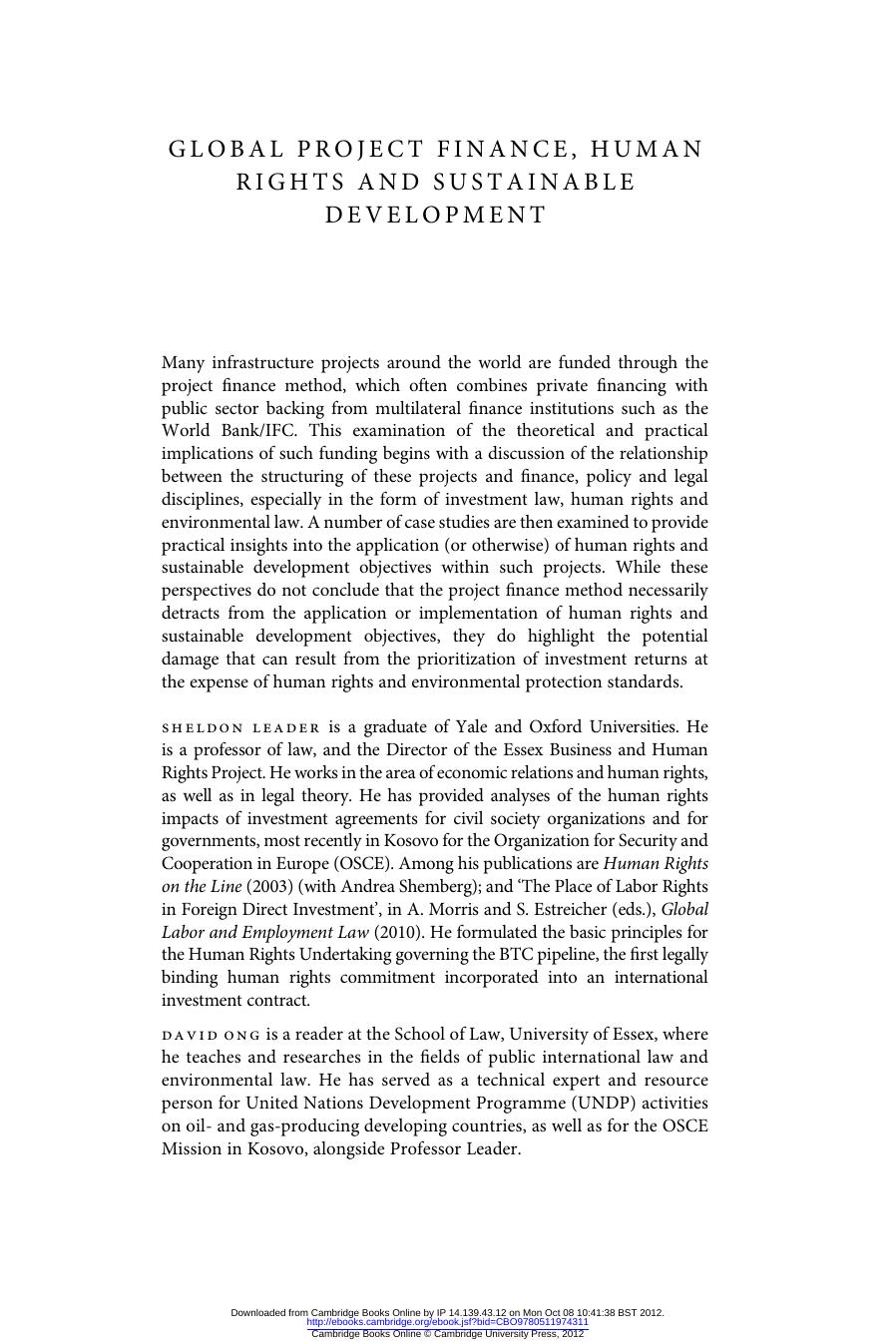Global Project Finance, Human Rights and Sustainable Development by Sheldon Leader & David Ong

Author:Sheldon Leader & David Ong
Language: eng
Format: mobi, pdf
Tags: Politics & Social Sciences, Politics & Government, Economics, Business & Investing, Public Affairs & Policy, Foreign & International Law, Political Science, Economic Policy & Development, Economic Policy, Public Policy, Law, Social Sciences
ISBN: 9780521762601
Publisher: Cambridge University Press
Published: 2011-09-28T18:30:00+00:00
Cambridge Books Online
http://ebooks.cambridge.org/
Global Project Finance, Human Rights and Sustainable Development
Edited by Sheldon Leader, David Ong
Book DOI: http://dx.doi.org/10.1017/CBO9780511974311
Online ISBN: 9780511974311
Hardback ISBN: 9780521762601
Chapter
10 - Irreparable damage, project finance and access to remedies by thi
rd parties pp. 278-316
Chapter DOI: http://dx.doi.org/10.1017/CBO9780511974311.011
Cambridge University Press
10
Irreparable damage, project finance and access to
remedies by third parties
j u d i t h s c h önsteiner
Introduction
Imagine an investment project in the extractive sector, such as an oil
pipeline, during the construction phase. Assume as well that the invest-
ors, usually a consortium of companies, have opted for project finance
(PF) and have made available considerable amounts of money for the
overall project, including exploration and construction, that will later
produce a revenue stream coming from oil, gas or minerals being
marketed. Until the extraction begins, the investors run a heightened
commercial risk: they have advanced their money, but cannot yet begin
to recover return. Furthermore, they know that lenders most probably
have, albeit limited, recourse to the sponsors’ assets to service the loans,
until the revenue phase begins. Sponsors therefore anxiously await the
flow of crude oil or the start of mining, fearing any prior surge in costs,
including those due to unexpected measures to protect human rights or
the environment. Time is money, especially when investment costs have
yet to be recovered. In that sense, projects that are quickly implemented
tend to heighten the risk of worker accidents, death threats for com-
munity members resisting economic activity, spills and damages to the
environment and irreversible health damages (see also Chapter 5 by
Sheldon Leader). At the same time, the host state, in this situation,
may be eager to create or maintain its reputation for an investor-friendly
environment, and be more lenient on the implementation of social
standards.
I am grateful to Sheldon Leader for his challenges to this argument throughout the process of drafting. Our discussions taught me a lot. I also thank Rasmiya Kazimova and Joo-Young
Lee for their helpful comments, and David Ong and Martin Barr for their fine editing. All
remaining errors are of course my own.
278
Downloaded from Cambridge Books Online by IP 14.139.43.12 on Mon Oct 08 10:42:36 BST 2012.
http://dx.doi.org/10.1017/CBO9780511974311.011
Cambridge Books Online © Cambridge University Press, 2012
i r r e p a r a b l e d a m a g e , p f a n d t h i r d - p a r t y r e m e d i e s 279
Imagine as well those individuals and communities living in proximity to
the project. While these projects do not usually require their labour, as
foreign specialists or workers are brought in, the people whose houses, fields,
or fresh water sources are close to the project’s installations fear that their
rights to property, health, food etc. may be violated. Environmental and
social impact assessment (ESIA) as well as human rights impact assessment
(HRIA) (see Chapter 7 by Tamara Wiher) should prevent most of the
damage from happening, and lenders in PF settings do usually require
such assessments. What is more, the International Finance Corporation
(IFC) Policy on Environmental and Social Sustainability requires its bor-
rowers to consider the implementation of risk avoidance measures, ‘when-
ever technically and financially feasible’. This provision constitutes a
conditional preventive approach.
Download
Global Project Finance, Human Rights and Sustainable Development by Sheldon Leader & David Ong.pdf
This site does not store any files on its server. We only index and link to content provided by other sites. Please contact the content providers to delete copyright contents if any and email us, we'll remove relevant links or contents immediately.
International Integration of the Brazilian Economy by Elias C. Grivoyannis(75588)
The Radium Girls by Kate Moore(11633)
Turbulence by E. J. Noyes(7716)
Nudge - Improving Decisions about Health, Wealth, and Happiness by Thaler Sunstein(7260)
The Black Swan by Nassim Nicholas Taleb(6782)
Rich Dad Poor Dad by Robert T. Kiyosaki(6191)
Pioneering Portfolio Management by David F. Swensen(6089)
Man-made Catastrophes and Risk Information Concealment by Dmitry Chernov & Didier Sornette(5664)
Zero to One by Peter Thiel(5503)
Secrecy World by Jake Bernstein(4402)
Millionaire: The Philanderer, Gambler, and Duelist Who Invented Modern Finance by Janet Gleeson(4113)
The Age of Surveillance Capitalism by Shoshana Zuboff(3998)
Skin in the Game by Nassim Nicholas Taleb(3978)
The Money Culture by Michael Lewis(3857)
Bullshit Jobs by David Graeber(3843)
Skin in the Game: Hidden Asymmetries in Daily Life by Nassim Nicholas Taleb(3736)
The Dhandho Investor by Mohnish Pabrai(3572)
The Wisdom of Finance by Mihir Desai(3538)
Blockchain Basics by Daniel Drescher(3339)
